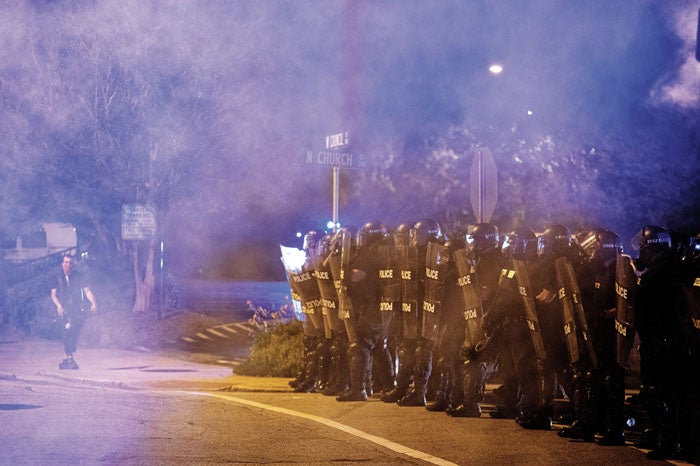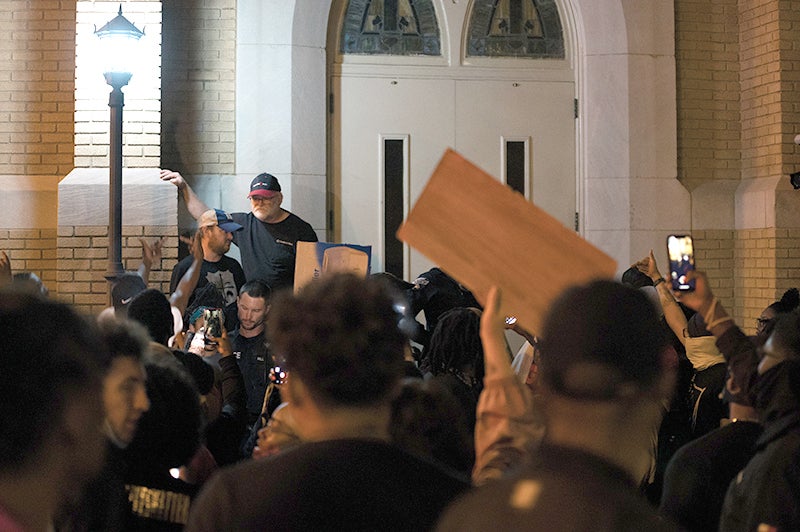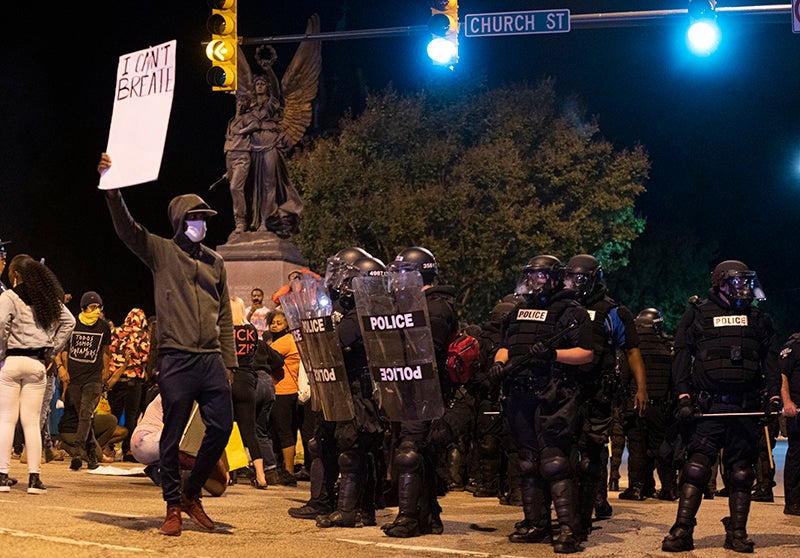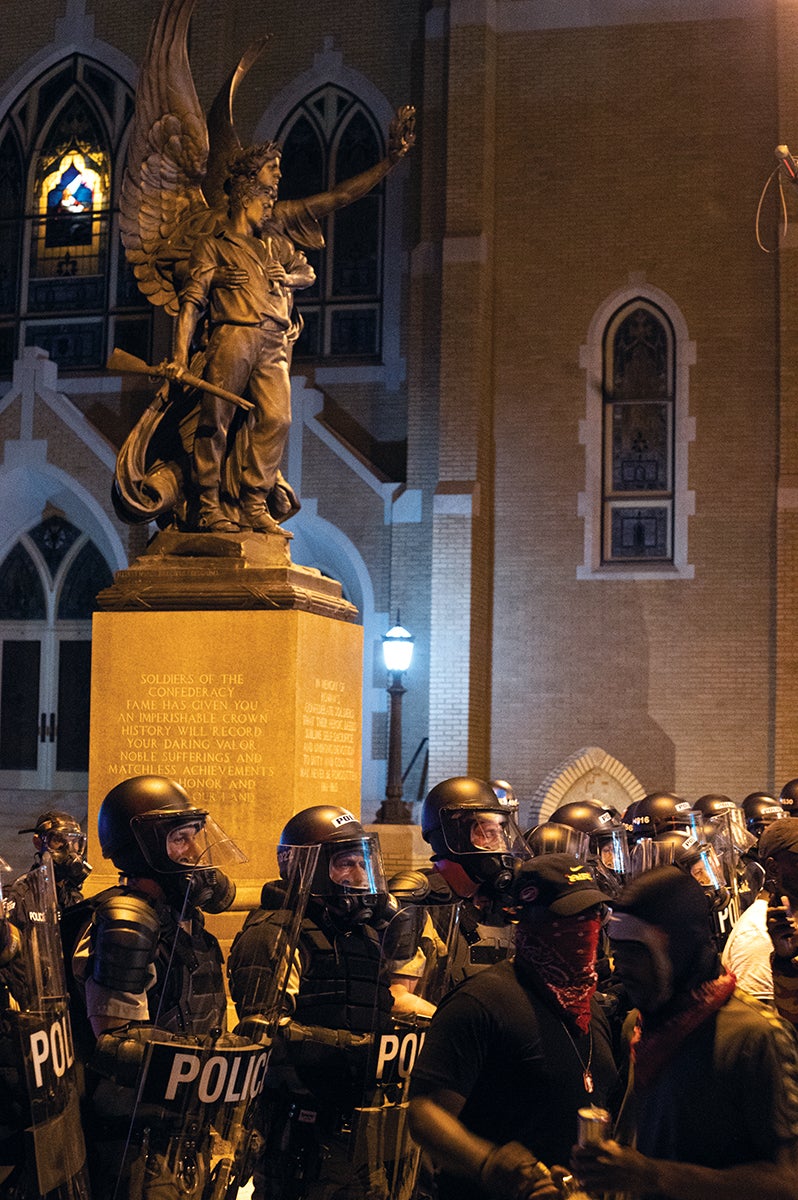No action taken on banning tear gas after divisive city council meeting
Published 11:42 pm Tuesday, August 4, 2020

- Josh Bergeron / Salisbury Post - Tear gas hangs in the air on June 1 as police in riot gear advance down West Church Street in downtown during a rally in front of the Confederate statue “Fame.”
By Natalie Anderson
natalie.anderson@salisburypost.com
SALISBURY — Tensions surrounding a proposal to halt the use of chemical agents by the Salisbury Police Department bubbled to a boil Tuesday in a divisive debate before the Salisbury City Council moved on without taking action.
Mayor Pro Tem Al Heggins, who proposed the ban, said her proposal wasn’t a commentary on the Salisbury Police Department or executive leadership of the department but rather a conversation on how leaders want citizens to be treated. She thanked the police for their work, and added she knew officers want to return home safely to their families.
Citing the National League of Cities’ guide to policing in the 21st century, Heggins said local leaders are key in fostering trust between the community and law enforcement. She also noted the effects of being exposed to tear gas, which includes burning sensations on the skin, choking, coughing, tearing and sometimes nausea and vomiting. Heggins, an Army veteran, said she’s been tear-gassed multiple times in different concentrations.
In an email to the Salisbury Post, City Attorney Graham Corriher said advisory letters issued by the North Carolina Attorney General’s Office in 2012 and 2017 indicate the city does not have the authority to adopt an ordinance banning the use of chemical agents by law enforcement officers.
Heggins’ request was for city leaders to review the policy in place by the city regarding the use of chemical agents as well as what other jurisdictions are doing to address riots in innovative ways that aren’t punitive to peaceful protesters. She also asked the council to replicate what Charlotte has done, which is to no longer purchase chemical agents such as tear gas.
Police chief’s presentation
Her presentation and request was followed by a presentation from Salisbury Police Chief Jerry Stokes, who cited numerous laws regarding the use of force by police. He cited North Carolina General Statutes 14-228.1, 14-228.2 and 14-288.4 regarding riots, civil disorders and emergencies. Those outline instances in which police are justified in using necessary force to de-escalate violence or threats of harm.
Stokes said tear gas has been used six times since 2016, when he took over as police chief. After presenting video footage of the events that took place at the June 1 protest when officers used tear gas to disperse a crowd, he said three pocket-sized canisters were used. The type of gas used that night was a sensory irritant with moderate degree of toxicity, Stokes said. He clarified that it was not necessarily a gas, but “a powder suspended in an inert smoke.”
Stokes said he directed the response to protests the night of June, and prefaced video footage from security cameras and officer body cameras by stating threats of assaults on police officers had been posted online earlier that day. He said there was confirmation from intelligence that multiple people associated with gangs would be attending the protest. He said the Rowan County Jail, Rowan County Courthouse and police department were specified as targets for violence.
The first video shown by Stokes pictured a group of protesters around 9 p.m. walking from the Big Lots parking lot to the downtown area. Stokes said no police were present because they were “tempered in their approach” to allow protesters to express themselves. Some protesters are shown in the video laying down in the streets. In that instance, Stokes said the police would have had the authority to arrest. He said police didn’t engage and “didn’t want to be heavy-handed.”
Footage then shows a patrol car approached protesters to deal with an individual who was armed with a rifle in the crowd. That gained attention and the crowd moved toward the officers. Stokes said the individual returned the rifle to a vehicle nearby and continued to protest.

Salisbury Post file photo – Protesters surround two men standing on the steps of St. Johns Lutheran Church after mistaking the identity of one man whom they thought had fired shots into the air the previous night. A police officer is standing between protesters and the men.
The crowd then mistakenly identified a person who they believed was the man who had been arrested for shooting bullets into the air near the “Fame” Confederate statue downtown the night before, Stokes said. Officers followed the crowd and protected the man after protesters moved toward him. A police vehicle escorted the mistaken man away from the crowd in a white SUV.
In the video, the crowd then moved toward the rear area of the jail. Stokes said he had to make decisions regarding how to react because he had seen the jail was a target on social media. He said the crowd reacted to a K-9 dog protecting the jail. It was then, he said, that it was mistakenly assumed shots were fired during the rush of protesters running from the county jail. No shots were fired.
The audio didn’t play during most of the presentation, but Stokes said protesters were chanting and cursing at police officers. He called for additional officers who were equipped with shields who assembled to protect the jail. A street barricade, water bottles and rocks were thrown at officers, he said, before the crowd began to push officers.
It was then that an initial canister of gas was deployed. Protesters picked up the canister and threw it back at officers, he said.
Stokes ended his presentation with current crime statistics. As of July 26, he said, the overall crime rate was down by 15%, but homicide was up 200%, aggravated assault was up by 20%, aggravated assault by gun was up by 93%, and violent crime overall was up by 4%.
“These are some disturbing numbers for me as your police chief,” he said before he implied there were more important things for the council to focus on than banning chemical agents.
Sheffield called that part of the presentation “propaganda.”
Council debate
Heggins reiterated that her proposal was a commentary for council members to set the tone for how citizens will be treated. While she said there were “lots I could say about that video operationally,” not every single protestor should be punished. Instead, agitators should be plucked out and removed, she said.
Mayor Karen Alexander held up a stack of at least 100 submitted comments from citizens opposed to the ban. She said one thing that struck her was that officers threw canisters on the ground, where no protestors were, and that people moved toward it and threw it back at officers. She called it unacceptable behavior from local citizens and said that such behavior must be controlled by law enforcement.
Heggins said the canister was thrown beyond protestors and in the pathway of the exit.
Council member Tamara Sheffield said she’s “not a trained police officer, but I’m a trained citizen and a human being.”
She questioned what actually led to officers showing up in riot gear. She added that she has been threatened multiple times at Salisbury Pride festivals and wasn’t protected, but police decided to protect themselves that night.

Salisbury Post file photo – A protestor holds up a sign that says “I can’t breathe” during the protest as he walks in front of police in riot gear near the “Fame” Confederate monument.
Sheffield also touched on a conversation sparked across the nation regarding “defunding the police.” She added that her intention wasn’t to defund the police, but to note the police are overfunded. Sheffield said that in recent fiscal year budgets police have added a deputy chief, an advisory committee, a victims advocacy group, partnerships with NAACP and plenty of other resources.
Budget increases?
During the public comment period, one Salisbury resident, Sharon Grant, called for the redistribution of funds allocated to Salisbury Police for resources aimed at marginalized populations in an effort to achieve equity. She asked for the fiscal year 2020-21 budget police allocation funding and how it compares to the previous year.
City manager Lane Bailey said the funding amounted to $10.2 million for the current fiscal year, which is up from last year’s allocation of $9.8 million. That’s an increase of $374,781, or 3.82%, according to the 2020-21 fiscal year budget.
But Bailey said while no raises were given, mid-year raises from the 2019-2020 budget year accounted for the larger amount in the 2020-21 budget, citing there was “essentially no difference.”
Police department morale
Council member David Post said the council was able to watch Stokes’ videos with the advantage of hindsight. He said it’s a lot easier to be critical sitting there watching and not being in the heat of moment.
He added that it’s difficult for Stokes or other officers to determine exactly who the agitators are and cited the threats that had been posted ahead of the protests, noting that officers should be able to use their judgment in these situations.
Post’s biggest concern, he said, is the morale of the police department and city staff, adding that he doesn’t like “second-guessing” police and that the city has spent a long time getting the police department fully staffed.
Heggins reiterated she has the respect for police and experience from the military with responses “in the moment.”
“This is a critique of council and what we’re willing to do to honor public safety for everybody,” she said, adding that her son is a police officer in the U.S. Navy.
Alexander said she spoke with council member Brian Miller, who wasn’t able to attend the meeting. Via Alexander, Miller said that he supports law enforcement and full access to the resources they need.
Alexander added that the officers should be allowed to do their jobs and not be micromanaged.
“The majority of council clearly supports, very highly, our police department and their reaction,” she said.
Bailey said Stokes plans for his advisory committee to review the night of June 1 and offer input on the response.
The council members moved on from the heated debate with no action, though Alexander said that there was a majority of council members who didn’t want to take action. She counted herself, Post and Miller in that group.

Salisbury Post file photo – Police in riot gear stand in front of the Confederate statue “Fame” during the protest, which drew a large crowd and prompted police to use tear gas.
Other comments
Also the public comment period, Seth Holtzman spoke in support of banning the use of tear gas, noting that “better policing” would have resulted in police officers arresting the few rowdy protestors at the June 1 protest downtown.
Holtzman said the use of tear gas is unconstitutional and unnecessary police violence, urging city council members to instead ask why they failed to instruct law enforcement ahead of time on how to de-escalate protests and handle them without the use of tear gas.
“These are the questions that demand your attention, but you haven’t asked them yet,” Holtzman said, adding the police officers tear gassing their own citizens is “despicable” and “disgusting.”
Local resident Kim Porter said city council members should mute people who throw insults at council members. He added that he felt “embarrassed” for attacks aimed at Heggins in recent council meetings.
Alexander responded to Porter’s comments and said Heggins wanted all letters and emails sent to council members regarding relocating the “Fame” Confederate statue on June 16 to be read verbatim. City Clerk Kelly Baker read all submissions aloud at that meeting, which spanned more than two hours during the public comment period. She added that Heggins was the only council member that received all submitted public comments.
“I believe we acted in good faith,” she said.
But Heggins responded to Alexander and said she didn’t condone any attacks against her. She added that she and Alexander met prior to the June 16 meeting to discuss the numerous public comments that were submitted, and that she hadn’t had time to read all the comments. Heggins said the decision to read all comments was honored since a different procedure wasn’t posted to the public in due time before the meeting.
Contact reporter Natalie Anderson at 704-797-4246.
Editor’s Note: This article was updated at 8 a.m. Aug. 5 to correctly attribute a quote to Councilwoman Tamara Sheffield. We apologize for the error.





